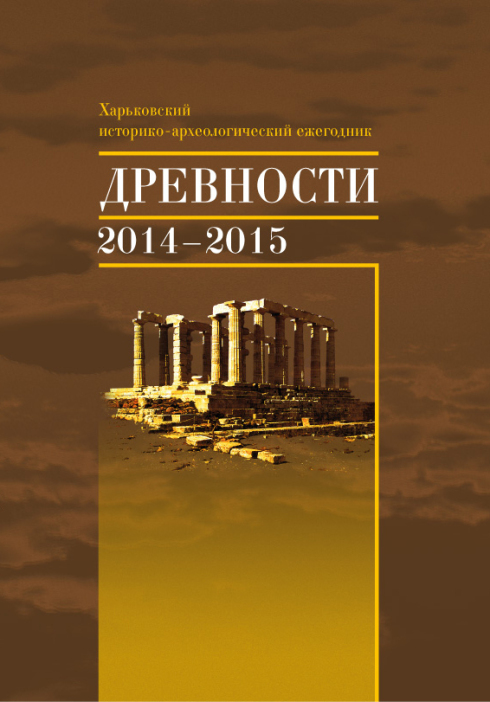«Завіса, що зветься воздух»: термінологія та реальний предмет
Анотація
У статті розглядається проблема згадування церковних завіс (καταπετάσμα) в ролі воздухів (ἀήρ) та виключення терміну «катапетасма» з перекладів оригінальних грецьких текстів на інші мови. Як наслідок виникає зникнення самого факту існування завіс у літургійному побуті. У роботі розбираються причини введення терміну «воздух» для означення предмету — завіса. Розглядаються декілька прецедентів, що показують випадки, коли словом «воздух» може бути названа саме завіса ківорію. Це відбувається коли: 1) термін «воздух» уживається на тому ж місті де до цього уживалася завіса; 2) термін «воздух» використовується в ролі її синоніма; 3) воздух символічно пояснюється так саме як і завіса; 4) поруч із воздухом є слова, що уточнюють, що це альтернативна назва предмету, що мається на увазі. Представлені факти показують необхідність переглядання ролі завіс ківорія в літургійній практиці у ранній візантійській період і уточнення зв’язаних з цим перекладів.
Завантаження
Посилання
Матвеева Ю. Г. Ткани в поэме Павла Силенциария: индития или завеса? // Вісник Харківської державної академії дизайну і мистецтв: Зб. наук. пр. — Х., 2011. — № 8.
Матвеева Ю. Г. Ткани для храма Св. Софии Константинопольской 360 года // Линтула. Сб. науч. ст. — СПб., 2012. — Вып. 5.
Матвеева Ю. Г. Велум: реальный прототип и иконографический символ // Линтула: сборник научных статей: [материалы науч. конф. VI Линтуловских чтений 2012 г.] — СПб., 2013. — Вып. 6.
Матвеева Ю. Г. Завесы с узлами: реальный прототип и иконографический символ // В созвездии Льва: Сборник статей по древнерусскому искусству в честь Льва Исааковича Лифшица. — М., 2014.
Св. Герман Константинопольский. Сказание о Церкви и рассмотрение таинств. — М., 1995. — Текст памятника парал. древнегреч., рус.
St. Germanus of constantinople. On the Divine Liturgy. The Greek Text with Translation, Introduction and Commentary by paul Meyendorff // Historia ecclesiarum. Vol. 9. — Crestwood, 1984.
Mathews T. F. The Early Churches of Constantinopole: Architecture and Liturgy. — University park; L., 1971.
Тафт Р. Ф. Занавешенный алтарь // Тафт Р. Ф. Упадок причащения в Византии и отдаление мирян от литургического действа: причина, следствие или ни то, ни другое? // Тафт Р. Ф. Статьи. — Т. 1. — Омск, 2010.
Троицкий В. А. История плащаницы // Богословский вестник, февраль. — Сергиев Посад, 1912.
Добронравов Г. С. История катапетасмы. — М., 1912.
Lampe G.W. H., D. D. A patristic Greek Lexicon. — Oxford, 1961.
Sophocles A. e. Greek Lexicon of the Roman and Byzantine periods. — Zűrich; N. Y., 1992.
http://el.orthodox/Πρωτοδευτέρα_Σύνοδος_Κωνσταντινουπόλεως_(κανόνες) Κανών ιβ´ (10); www.krotov.info/acts/2/0861kpl.html — Правило 10.
Прот. Цыпин Владислав, Литвинова Л. В. Апостольские правила // Православная энциклопедия. — www.pravenc.ru/text/Апостольские правила.html
http://users.uoa.gr/~nektar/orthodoxy/tributes/regulations/00_apostolic.htm. Κανών ΟΓ´; www.agioskanon.ru/apostol/001.htm. — Правило 73.
Константин Багрянородный. Церемонии // PG. — 1897, Р. — Vol. 112.
Wessel K. Ciborium // RBK. — Stuttgart, 1973.
Brightman F. E. Liturgy of the presanctified // Liturgies Eastern and Western. — Oxford University press, 1965.
Киприан. Архимандрит (Керн). Евхаристия. — М., 2001.




